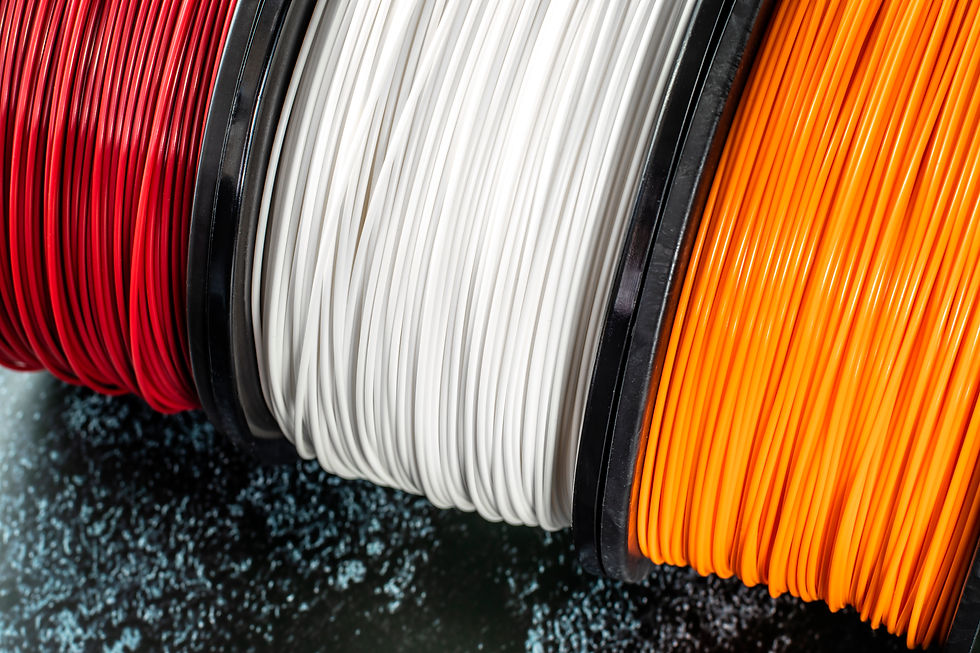The Exciting Future of 3D Printing: Trends, Predictions, and Limitless Potential
- Ashley Glenn
- Apr 22, 2024
- 3 min read
3D printing has undergone an extraordinary evolution since its inception, transforming from a novel method for creating simple prototypes into a disruptive technology that impacts industries ranging from aerospace to healthcare. As we gaze towards the future, the trajectory of 3D printing is set to revolutionize production processes, democratize manufacturing, and even push the boundaries of creativity and customization.
1. Advancements in Materials
Traditionally, 3D printing has been dominated by plastics and basic polymers, but the horizon is expanding rapidly. Researchers and companies are experimenting with a wide range of materials, including advanced composites, ceramics, and even new forms of metals. These materials will open up new applications in sectors where durability, weight, flexibility and environmental resistance are critical. Furthermore, the development of sustainable, biodegradable materials will address environmental concerns associated with manufacturing.

2. Increased Adoption across Industries
While 3D printing has already made significant inroads in various industries, such as aerospace, automotive, and healthcare, its adoption is expected to increase further. The ability to produce highly customized products on-demand, reduce waste, and streamline supply chains will drive more companies to embrace additive manufacturing.
3. Construction and Housing Revolution
The potential for 3D printing in construction is vast, promising to reduce labor costs, decrease construction waste, and significantly speed up building processes. We're already seeing examples around the world where entire buildings and structures are being printed. As the technology advances, 3D printing is set to play a major role in addressing housing crises, creating affordable housing solutions, and perhaps even building off-world habitats in space or other planets.
4. Precision Medicine and Bioprinting
One of the most profound impacts of 3D printing is in the field of healthcare, particularly through bioprinting. Future advancements are expected to allow for the printing of complex, functional organs tailored to individual patients, potentially revolutionizing organ transplantation. In addition to organ printing, 3D printing is set to expand further into prosthetics and implants, providing customized solutions that are significantly more affordable and accessible.
5. Automotive and Aerospace Innovation
The automotive and aerospace sectors have already embraced 3D printing for its ability to reduce weight and consolidate complex parts. The future will likely see an escalation in this trend, with entire sections of vehicles or spacecraft being printed. This shift will not only reduce the costs and complexities of manufacturing but also enhance the performance of vehicles and crafts by allowing for lighter and more efficient designs.

6. Disruption of Retail and Supply Chains
3D printing is poised to disrupt traditional supply chains by enabling on-demand production closer to the end consumer. This shift will minimize the need for inventory and reduce shipping distances, leading to lower costs and environmental impact. For the retail sector, this means the possibility of highly customized products, crafted to the consumer's specifications in real-time, enhancing the customer experience and engagement.
7. Educational and Creative Tools
As 3D printers become more accessible and affordable, they will also become a staple in educational settings. This technology not only serves as a powerful tool for STEM education, fostering creativity, innovation, and problem-solving skills, but it also provides students with the means to experiment and learn in a highly interactive and tangible way.

8. Sustainable Manufacturing
3D printing has the potential to significantly reduce waste and energy consumption compared to traditional manufacturing methods. By producing only the required amount of material and eliminating excess waste, 3D printing can contribute to a more sustainable and eco-friendly future. Additionally, the ability to print spare parts on-demand could reduce the need for excessive inventory and transportation.
9. Ethical and Regulatory Development
With all technological advancements, 3D printing will also face ethical and regulatory challenges, particularly concerning bioprinting and intellectual property rights. The future will necessitate a careful balance between innovation and regulation to protect individual rights without stifling creativity and progress.
The Future of 3D Printing
The future of 3D printing is vibrant and poised for substantial growth across various domains. From creating homes and human organs to revolutionizing how we produce and consume products, the potential is nearly limitless. As we continue to innovate and improve upon this transformative technology, one thing remains clear: 3D printing will play a crucial role in shaping our future, enabling sustainable manufacturing, democratizing production, and pushing the boundaries of what is possible.




Comments